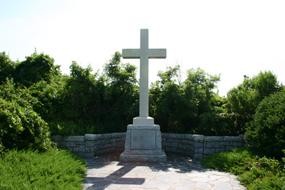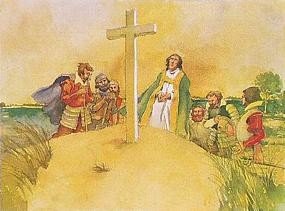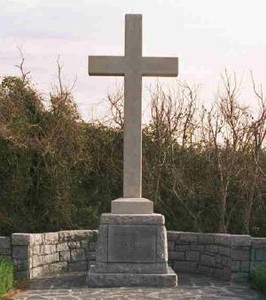Cape Henry Memorial Cross
Introduction
Text-to-speech Audio
The Cape Henry memorial commemorates the first ships to land at Cape Henry, located in Virginia Beach, VA. These British ships were among the first to settle the areas that would become British North America and later Anglo Canada before finally becoming the United States. During the landing of the original ships in April 1607, the explorers were attacked by Native Americans using bows though they were quickly repelled by the colonist gunfire, this proved a valuable lesson for future settlers.
Images
A photo of the cross as it stands today, erected in 1935.

Water color photo of Reverent Hunt who is leading a prayer at the wooden cross of Cape Henry

Another photo of the modern cross.

An aerial photo of the location showing the area where the first expeditions would have landed.

Backstory and Context
Text-to-speech Audio
Cape Henry, located on the Atlantic shore of Virginia in the northeast corner of Virginia Beach is the southern boundary of the Chesapeake Bay is the site where some of the first settlers landed, and where the town of Jamestown got it's origins. The sailors had originally broadly referred to the place as Chesupioc Bay, but it was renamed Cape Henry in honor of Henry Frederick, the Prince of Wales and eldest son of King James the first. [1] Of course, the bay area is still called Chesapeake today, an interpretation on the original Chesupioc Bay.
George Percy, a sailor employed by the London Company, branch of the proprietary Virginia Company and captained by Christopher Newport was one of the only members to keep a diary. His diary detailed the events of their four and a half month journey across the Atlantic, as well as the first sight of the North American continent on April 26, 1607. He details the beautiful landscape: meadows, forests, rivers, trees and nearly everything else he sees, including the attacks on their crew by Native Americans. "There came the savages creeping upon all four, from the hills, like bears; with their bows in their mouths: charged us very desperately head on." [1] Two members of the crew were injured in this attack, the captain Gabrill Archer sustaining wounds to both his hands and another soldier was shot twice in the body. "After they had spent their arrows and felt the sharpness of our shot; they retired into the woods with great noise, and so left us."
The men continued to explore for the next several days, and on the 29th of April, 1607 the crew erected a wooden cross upon the sands as a way of saying thanks for their safe passage to a new land. The cross stood until it was replaced in 1935 with the current stone monument by the national society Daughters of The American Colonists. If you wish to visit the cross it is open 24 hours a day, however you can visit the nearby lighthouse to receive a national park passport stamp. [1]
George Percy, a sailor employed by the London Company, branch of the proprietary Virginia Company and captained by Christopher Newport was one of the only members to keep a diary. His diary detailed the events of their four and a half month journey across the Atlantic, as well as the first sight of the North American continent on April 26, 1607. He details the beautiful landscape: meadows, forests, rivers, trees and nearly everything else he sees, including the attacks on their crew by Native Americans. "There came the savages creeping upon all four, from the hills, like bears; with their bows in their mouths: charged us very desperately head on." [1] Two members of the crew were injured in this attack, the captain Gabrill Archer sustaining wounds to both his hands and another soldier was shot twice in the body. "After they had spent their arrows and felt the sharpness of our shot; they retired into the woods with great noise, and so left us."
The men continued to explore for the next several days, and on the 29th of April, 1607 the crew erected a wooden cross upon the sands as a way of saying thanks for their safe passage to a new land. The cross stood until it was replaced in 1935 with the current stone monument by the national society Daughters of The American Colonists. If you wish to visit the cross it is open 24 hours a day, however you can visit the nearby lighthouse to receive a national park passport stamp. [1]
Sources
United States. National Park Service. "Cape Henry Memorial Cross." National Parks Service. Accessed June 11, 2016. https://www.nps.gov/came/cape-henry-memorial-cross.htm.
